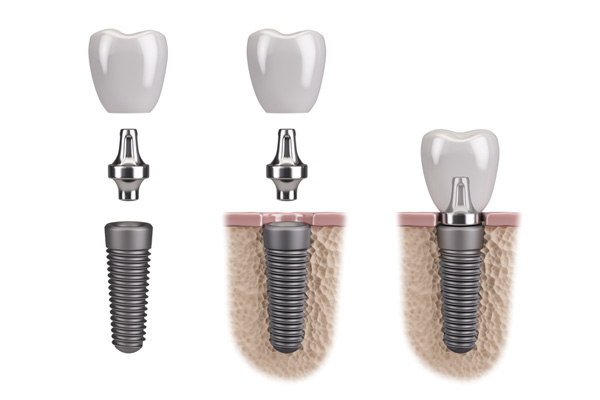What Are the Different Types of Dental Implants?
 Dental implants are artificial roots that a dentist surgically places into the jawbone. The prosthetic tooth is then attached to the implant and acts like a real tooth, replacing missing teeth or repairing broken ones. This guide will review the three different types of dental implants available today.
Dental implants are artificial roots that a dentist surgically places into the jawbone. The prosthetic tooth is then attached to the implant and acts like a real tooth, replacing missing teeth or repairing broken ones. This guide will review the three different types of dental implants available today.
3 types of dental implants
1. Endosteal dental implants
Endosteal implants contain titanium that dentists place into the jawbone. They anchor to the jawbone by using the jawbone itself rather than attaching to existing teeth or dental roots. Endosteal implants can replace a single missing tooth or multiple missing teeth. The dentist will often use these implants for patients who have experienced jawbone loss due to cancer or other illnesses.
2. Subperiosteal dental implants
Subperiosteal dental implants replace missing teeth in either the upper or lower jaw. These types of implants are much easier to place than other types that do not require bone grafting. The dentist does not need to drill into the patient’s jawbone.
The dentist will surgically place the dental implant under the gum line so that only part of its structure protrudes above it, allowing for easier cleaning than endosteal implants. It also requires less bone growth before use because not as many cells are involved with healing after surgery (which could lead to problems later on).
3. Zygomatic dental implants
Zygomatic implants are similar in appearance but different from subperiosteal models because they sit higher on one’s face. Like subperiosteal dental implants, these implants typically do not require a bone graft. Zygomatic implants require more bone growth prior to placement but result in less discomfort once inserted into place because they do not rub against any soft tissues during daily activities like chewing, drinking, etc. These implants replace teeth lost due to trauma and periodontal disease.
Enhancements for success
In some cases, patients must undergo an enhancement to help place one of the above dental implants. The following enhancement options may improve the patient’s chances of dental implant candidacy:
- Bone graft: The dentist can perform a bone graft in two ways. They can either take healthy bone from another part of the body (donor site) and place it into another area where the bone is needed (recipient site) or use a synthetic material that simulates natural bone and place it where it is needed.
- Sinus augmentation: This procedure aims to increase the sinus volume, which is located under the gum tissue. The sinus is an area where bone buildup occurs as part of the natural healing process after tooth extraction. The dentist may also recommend this enhancement to improve the shape and size of the patient’s jawbone.
- Ridge augmentation: This procedure is similar to sinus augmentation but involves adding material to the roof of the mouth, not just around the socket. Ridge augmentations are mainly used when no natural ridge is available for placing an implant or if the patient has lost significant amounts of bone that would otherwise cause problems with their bite alignment.
Discover your options
Dental implants are a great option, and one of the most secure, for replacing missing teeth.
Request an appointment or call Thanasas Family Dental Care at 248-260-2878 for an appointment in our Troy office.
Recent Posts
The surgical procedure to place dental implants is similar to all others in that you need some time to recover from the operation. Implants require incisions, so the soft tissues will need to heal to seal up the wounds. In addition, the hard tissues of the jaw bone will also heal slowly, fusing the metal…
Studies show that dental implants remain the gold standard in dental restorations. These dental replacements are the most stable ones that you can get. It may be invasive, but once it heals well, you will have good dental function again. Here are the details about the process of getting dental implants.The dentist will examine the…
Dental implants are a leading choice for many patients when it comes to tooth replacement. Patients like the idea of a tooth replacement option resembling natural teeth. Dental implants look natural and perform like a permanent natural tooth. Therefore, there is no need to take the tooth replacement out daily for cleaning or worry about…


